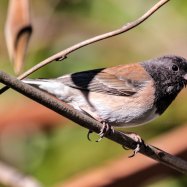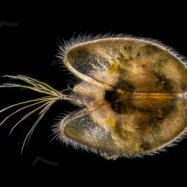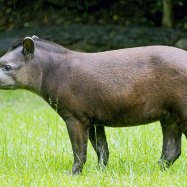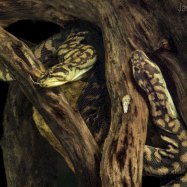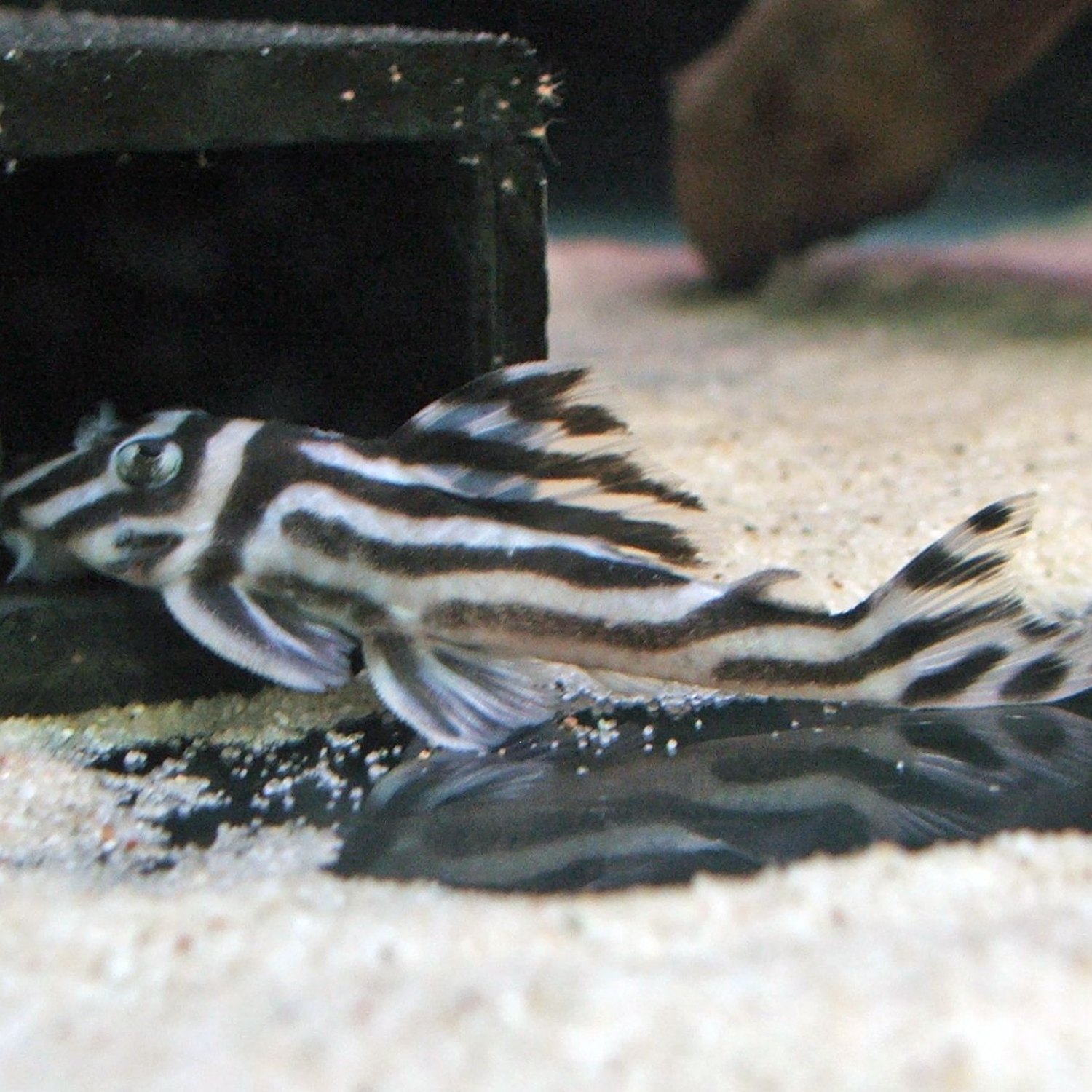
Zebra Pleco
Up to 3.5 inches
Meet the Zebra Pleco - a unique freshwater fish that can grow up to 3.5 inches in length and is known for its distinct striped pattern. Found in the Rio Xingu in the Amazon Basin, this fish belongs to the Loricariidae family and has a cylindrical body shape. Keep this beautiful species in your aquarium for a touch of the Amazon in your home. #ZebraPleco #freshwaterfish #AmazonBasin #aquarium #unique
Animal Details Summary:
Common Name: Zebra Pleco
Kingdom: Animalia
Habitat: Freshwater
A Closer Look at the Fascinating Zebra Pleco
The animal kingdom is home to a diverse range of unique and fascinating creatures, each with its own distinctive features and characteristics. Among these amazing creatures is the Zebra Pleco (Hypancistrus zebra), a small freshwater fish native to South America, particularly Brazil. Although it may not be as popular as some of its aquatic counterparts, the Zebra Pleco has been gaining attention and recognition among fish enthusiasts in recent years. In this article, we'll delve deeper into what makes the Zebra Pleco stand out and why it is a sought-after addition to any aquarium Zebra Pleco.Meet the Zebra Pleco
The Zebra Pleco belongs to the Loricariidae family, which is known for its armored catfishes. It is a relatively small fish, growing only up to 3.5 inches in length, with a cylindrical body shape. Its scientific name, Hypancistrus zebra, is derived from the Greek words “hypnos” meaning “under”, “ankistros” meaning “anvil”, and “zebra” referring to its distinctive black and white stripes.The Zebra Pleco is easily recognizable by its striking coloration, a striking contrast of black and white stripes covering its entire body. This coloration serves as excellent camouflage in its natural habitat, as it allows the fish to blend in with the rocky riverbeds and avoid predators.
A Natural Habitat Like No Other
The Zebra Pleco is mainly found in the Rio Xingu, a tributary of the Amazon River located in northern Brazil. This fast-flowing river is characterized by rocky riverbeds and strong currents, making it an ideal habitat for these fish. In the wild, Zebra Plecos are typically found in the lower parts of the river, where the water is relatively shallow and the current is not as strong Zebra Mussels.As with most freshwater fish, the environmental conditions in their natural habitat are crucial to their survival. The Rio Xingu is rich in plant life, providing a constant source of food for the Zebra Pleco. In addition, the water in the river has a neutral pH level, which is an essential factor for maintaining the fish's health. Therefore, it is crucial for those who keep Zebra Plecos as pets to replicate similar conditions in their aquarium.
Diet and Feeding Habits
Zebra Plecos are omnivorous, meaning they feed on both plant and animal matter. In the wild, their diet mainly consists of algae, small crustaceans, and insects. In captivity, it is essential to provide a well-balanced and varied diet for these fish. A high-quality sinking pellet specifically designed for bottom-dwelling fish is an excellent staple food for Zebra Plecos. In addition, it is recommended to supplement their diet with fresh or frozen bloodworms, brine shrimps, and blanched vegetables such as zucchini and cucumber.Aquarium Setup for Zebra Plecos
Setting up an aquarium for Zebra Plecos requires careful consideration of their natural habitat. As these fish are bottom-dwellers, the aquarium should have a substrate of fine sand or smooth river rocks to prevent injury to their delicate bodies. It is also crucial to provide ample hiding places, such as caves and rocky crevices, as these fish are shy and prefer to hide away. Adding live plants, particularly ones with broad leaves, will also make the Zebra Pleco feel more at home, as they enjoy grazing on algae and biofilm that grows on plant surfaces.Maintaining a pH level of 6.5 to 7.5 and a water temperature between 78-82°F is crucial for the health and well-being of Zebra Plecos. Regular water changes are also necessary to keep the water quality at an optimum level. It is recommended to keep these fish in groups of at least 3-5, as they are social animals and thrive in a community setting.
Breeding Zebra Plecos
Breeding Zebra Plecos can be quite challenging, as they require specific conditions to spawn successfully. In their natural habitat, these fish usually breed during the rainy season when the water is warmer and the river current is stronger. It is essential to replicate these conditions in captivity for successful breeding.During the breeding process, male Zebra Plecos become more aggressive and territorial. They will claim a suitable cave or hiding spot and defend it from other males. The female will lay eggs inside the cave, and the male will fertilize them. These eggs will hatch after 6-7 days, and the male will continue to protect the fry until they become independent. Breeding Zebra Plecos can be a rewarding experience for fish enthusiasts, but it requires careful planning and close attention to details.
A Popular and Valuable Aquarium Fish
The Zebra Pleco's striking appearance and unique characteristics have made it a highly sought-after addition to aquariums all over the world. However, its popularity has caused a significant decline in its population in the wild, making it a rare and valuable species. In order to preserve the species, many fish enthusiasts and breeders are working towards sustainable breeding programs. As a result, the Zebra Pleco is now readily available in the market, making it possible for aquarium owners to enjoy these beautiful fish without causing harm to the environment.In Conclusion
In conclusion, the Zebra Pleco is a fascinating and valuable addition to any aquarium. Its distinctive black and white stripes, natural habitat, and breeding habits make it a unique and sought-after species. Proper care and attention to detail are necessary to ensure the well-being of these fish in captivity. And with responsible breeding practices, we can all contribute to preserving this incredible species for future generations to enjoy. So, the next time you come across a Zebra Pleco, take a closer look and appreciate the beauty and uniqueness of this hidden gem of the aquatic world.

Zebra Pleco
Animal Details Zebra Pleco - Scientific Name: Hypancistrus zebra
- Category: Animals Z
- Scientific Name: Hypancistrus zebra
- Common Name: Zebra Pleco
- Kingdom: Animalia
- Phylum: Chordata
- Class: Actinopterygii
- Order: Siluriformes
- Family: Loricariidae
- Habitat: Freshwater
- Feeding Method: Omnivorous
- Geographical Distribution: South America
- Country of Origin: Brazil
- Location: Rio Xingu, Amazon Basin
- Animal Coloration: Black and white stripes
- Body Shape: Cylindrical
- Length: Up to 3.5 inches
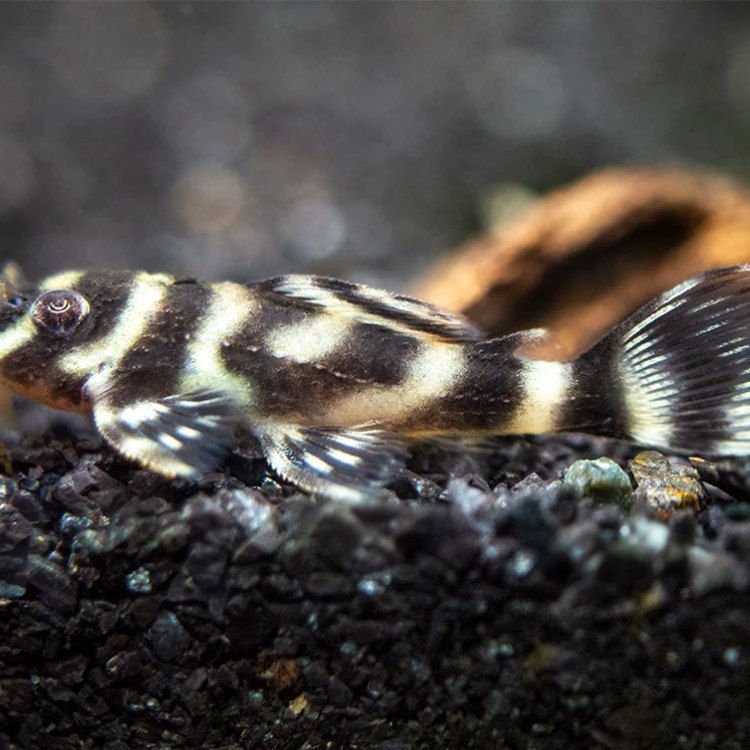
Zebra Pleco
- Adult Size: 2.5 - 3 inches
- Average Lifespan: 10 - 15 years
- Reproduction: Egg-layers
- Reproductive Behavior: Guard and fan eggs
- Sound or Call: Unknown
- Migration Pattern: Non-migratory
- Social Groups: Solitary
- Behavior: Nocturnal
- Threats: Habitat loss, pollution, overfishing
- Conservation Status: Vulnerable
- Impact on Ecosystem: Keystone species in freshwater ecosystems
- Human Use: Popular aquarium fish
- Distinctive Features: Distinct black and white striped pattern
- Interesting Facts: Zebra Plecos are known for their unique coloration and are highly sought after by aquarium enthusiasts.
- Predator: Unknown
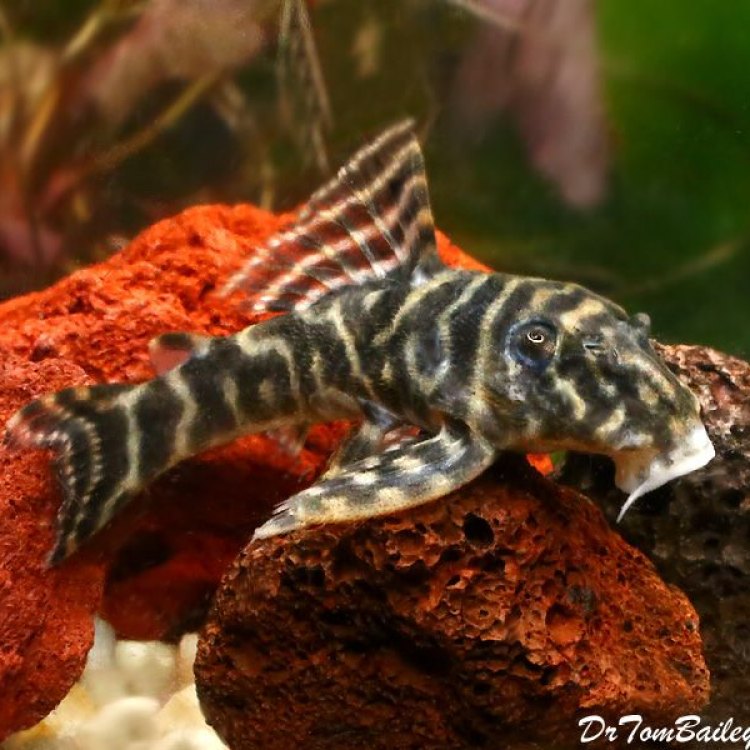
Hypancistrus zebra
The Fascinating World of Zebra Plecos: A Keystone Species in Freshwater Ecosystems
From the depths of the Amazon river basin, a small but striking fish has captured the hearts of aquarium enthusiasts around the world. Known for its distinct black and white stripes and nocturnal behavior, the Zebra Pleco is a truly unique and captivating species.In this article, we will take a deep dive into the world of Zebra Plecos, exploring their physical characteristics, behavior, conservation status, and impact on the ecosystem. So, let's get ready to explore the fascinating world of these striped beauties PeaceOfAnimals.Com.
The Basics: Adult Size and Lifespan
The Zebra Pleco, scientifically known as Hypancistrus zebra, is a small fish, with an adult size ranging from 2.5 to 3 inches. This size makes them a perfect addition to small or medium-sized aquariums, as they do not require a lot of space.But don't be fooled by their size, as these little fish have a lifespan of 10 to 15 years when provided with proper care. This means that bringing a Zebra Pleco into your aquarium is a long-term commitment that requires dedication and responsibility.
Reproduction and Unique Reproductive Behavior
Zebra Plecos are egg-layers, meaning that the female will lay eggs which the male fertilizes externally. These eggs are then guarded and fanned by the male until they hatch.What makes the Zebra Pleco's reproductive behavior truly unique is the role of the male in the process. While most male fish may have some involvement in protecting the eggs, male Zebra Plecos take it to the next level Zebra Snake. They are not only responsible for guarding the eggs from potential predators, but they also fan the eggs to provide oxygen and ensure their proper development.
This behavior is not only fascinating to observe, but it also showcases the impressive parental instincts of these fish.
Mysterious Sound or Call
When it comes to communication, the Zebra Pleco is a bit of a mystery. There is no known sound or call associated with these fish. It is believed that they communicate through visual signals and possibly chemical cues. Studying their communication patterns is an area that is still being explored by researchers.Migratory Patterns and Social Groups
Unlike some other fish species, Zebra Plecos are non-migratory, meaning they do not travel long distances for breeding or other purposes. They are typically solitary creatures and prefer to spend most of their time alone.In the wild, Zebra Plecos are known to dwell in caves and crevices, making it difficult to spot them. This is another reason why they are solitary creatures, as living in such areas does not allow for large social groups.
Nocturnal Behavior
One of the most distinctive behaviors of Zebra Plecos is their nocturnal nature. They are primarily active at night, searching for food and carrying out their reproductive duties. During the day, they can be found hiding in caves or other dark places, making it challenging to observe them.This is another reason why these fish are highly sought after by aquarium enthusiasts. Their nocturnal behavior adds an element of mystery to their already unique and alluring qualities.
The Threats: Habitat Loss, Pollution, and Overfishing
Unfortunately, like many other species in the Amazon river basin, Zebra Plecos are facing significant threats to their survival. Habitat loss due to deforestation is a major concern, as it affects the quality of water and can lead to their decline in the wild.Pollution is another significant threat as human activities such as mining, agriculture, and urban development have polluted the rivers. This pollution not only affects the Zebra Plecos directly but also impacts their food sources and overall ecosystem.
Overfishing is another major concern, as Zebra Plecos are highly valued in the aquarium trade. While they are bred in captivity, the overexploitation of their wild populations for commercial purposes can harm their numbers in their natural habitat.
Conservation Status: Vulnerable
Due to the various threats faced by Zebra Plecos, their conservation status has been classified as vulnerable by the International Union for Conservation of Nature (IUCN). This means that there is a high risk of their population declining in the wild, and urgent conservation efforts are needed to protect them.Some initiatives, such as the Amazon Rescue Center, have been established to help preserve the Zebra Plecos and other endangered species in the Amazon river basin. These efforts aim to educate the public, regulate the aquarium trade, and promote sustainable practices to protect the species and its habitat.
Impact on the Ecosystem: A Keystone Species
Despite their small size, Zebra Plecos play a vital role in their ecosystem, making them a keystone species. Keystone species are those that have a crucial role in maintaining the balance and diversity of their environment.In the case of Zebra Plecos, they help regulate the population of their food sources, such as insects and other small aquatic creatures. This, in turn, affects the populations of other species that feed on the same food sources, creating a ripple effect throughout the ecosystem.
If the population of Zebra Plecos were to decline or disappear, it could have severe consequences on the entire ecosystem. This highlights the importance of protecting and conserving this species for the overall health and balance of their habitat.
Human Use: A Popular Aquarium Fish
Despite their conservation status, Zebra Plecos remain a highly sought after fish in the aquarium trade. Their unique coloration, behavior, and ability to thrive in small tanks make them a popular choice for aquarium enthusiasts.However, it is essential for those interested in owning a Zebra Pleco to ensure that they are sourced responsibly. Only purchase fish that are bred in captivity and avoid supporting the capture and trade of wild Zebra Plecos.
Distinctive Features: Black and White Stripes
Of course, we cannot talk about Zebra Plecos without mentioning their most distinctive feature – their black and white stripes. These stripes give them their name and make them stand out among other fish in the aquarium world.The stripes are not just for show; they also serve as a natural camouflage in their rocky and dimly lit habitats. This helps them blend in with their surroundings, making it easier to hide from potential predators.
Interesting Facts: The Quest to Breed Zebra Plecos
Zebra Plecos are not only fascinating to observe but also come with an interesting backstory. Due to their popularity in the aquarium trade, there is a strong desire among enthusiasts to breed them in captivity.However, this has proven to be quite a challenge, as the process of spawning, fertilization, and hatching is still not fully understood. As a result, there are only a few successful breeders of Zebra Plecos, making them even more valuable and sought after in the trade.
Predators: Mystery Surrounding their Natural Enemies
While there is little information on the sound or call of Zebra Plecos, there is even less known about their natural predators. These elusive fish are often considered preyed upon by larger fish, but there is no concrete evidence to support this.In their natural habitat, Zebra Plecos are masters of camouflage, making it difficult for predators to spot them. However, with the increasing threats to their habitat and population, it is essential to understand their natural enemies and work towards protecting them from harm.
In Conclusion
The Zebra Pleco is a truly remarkable and unique species, with its striking appearance, behaviors, and role in the ecosystem. As their population continues to decline in the wild, it is crucial for us to educate ourselves and others about the importance of conserving this species.By understanding their distinctive features, reproductive behavior, and impact on the ecosystem, we can appreciate and admire these striped beauties even more. And for those looking to add a Zebra Pleco to their aquarium, always remember to source responsibly and promote sustainable practices to protect these fascinating fish for generations to come.
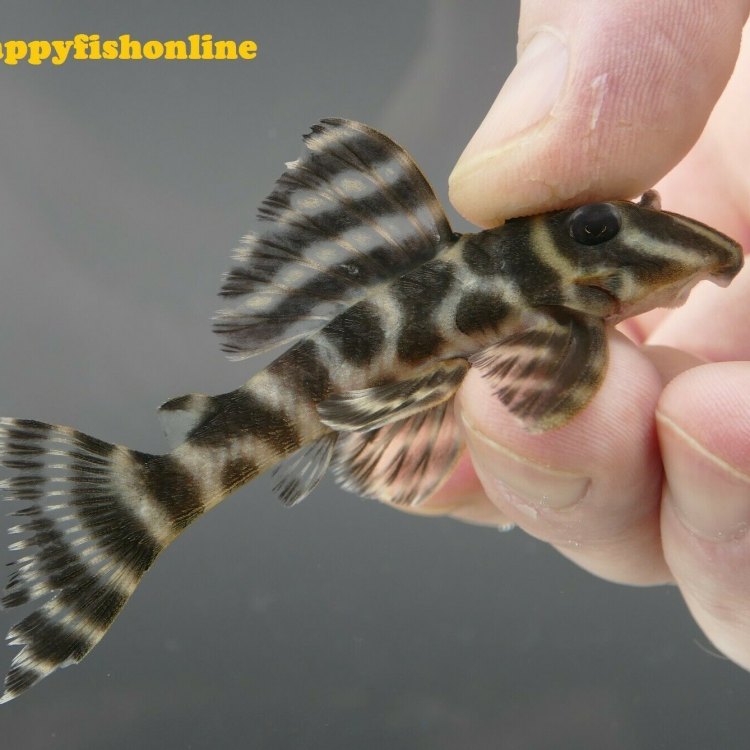
A Closer Look at the Fascinating Zebra Pleco
Disclaimer: The content provided is for informational purposes only. We cannot guarantee the accuracy of the information on this page 100%. All information provided here may change without prior notice.



